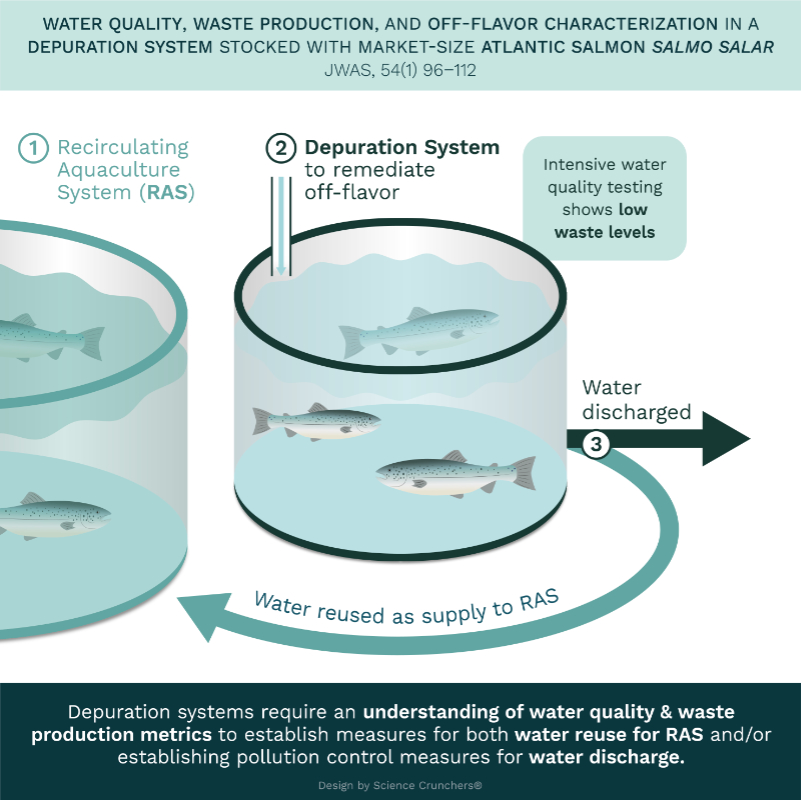JWAS Editor's Choice Awards 56(1)
The use of integrated multi-trophic aquaculture (IMTA) for multi-species culture is not new, but thi...

Many challenges come with land-based finfish aquaculture. This study looks at water quality changes during remediation of off-flavor that can accumulate in Atlantic salmon, Salmo salar, reared in recirculating aquaculture systems (RAS). To eliminate off-flavor from salmon flesh, depuration may be necessary. Therefore, the authors emphasize the need to understand water quality and waste production in the context of depuration, discharge requirements, or repurposing water back into the RAS. This study evaluated these parameters for 311 salmon ranging in size from 5–6 kg. These fish were reared to this size in a freshwater RAS and then moved to a depuration tank. Feed was withheld one day prior to transfer and fish remained off-feed for the 7 days of the study. It was found that within hours after stocking, levels of total suspended solids (TSS), total phosphorus (TP), and total ammonia nitrogen (TAN) increased sharply then declined. By the end of the trial TSS and TP were low but TAN plateaued, suggesting catabolism of somatic tissue. Geosmin and 2-methylisoboreol levels were also low throughout the study. This work represents the first comprehensive analysis of water quality and waste production metrics during the depuration process of RAS-produced Atlantic salmon. Recommendations from this study include extending the duration of preliminary feed withholding prior to transfer into depuration systems and reintroducing depuration system water strategically within RAS to rapidly remove residual solids and ammonia r prior to water reuse. These data provide important water quality measures to consider in design or configuration of existing or new RAS facilities.
In this review paper, the authors synthesize recent literature with a focus primarily on nutritional and health benefits of abalone feeds. Such feeds tend to include macroalgae (seaweed) as the primary feed component and in some countries, seaweed is cultivated and harvested specifically for feeding of abalone. However, in many cases abalone farms utilize formulated feeds extensively. Most land-based abalone farms use formulated feeds containing various levels of seaweed and other plant and animal based ingredients. Despite such feed options, there are major gaps in understanding the nutritional requirements of abalone and a need for industry to drive research priorities in this area. The authors state that a range of nutritional research topics should be explored including long-term evaluation of aquafeeds across seasons and life stage. In addition, economic assessment of feed production costs, environmental impacts, histological studies on the effects of alternative ingredients on digestive health of abalone, and nutritional aspects of integrated multi-trophic aquaculture of abalone are all areas where more information is needed. With increasing production of abalone for commercial and restoration aquaculture, this paper provides a comprehensive overview of what we know and identifies many priority areas for future abalone nutrition research.
Regulations and their economic impact on aquaculture producers has been a hot topic and this study provides insights into specific regulatory compliance costs and the burden they pose to US catfish farms. Survey interviews were conducted in the major catfish-producing states, and the results indicated that the US catfish industry spends approximately $45 million on regulatory costs annually. Environmental regulations related mostly to the management of piscivorous birds was found to have the greatest cost (approximately $18 million) followed by labour regulations, and taxes/insurance. Interestingly, it was found that regulatory costs on smaller farms (<80 ha) were 2.6 times higher on average than larger farms of >300 ha. Results from this study highlight the overall economic effect of regulatory action on US catfish aquaculture. This is important, and by identifying which regulations impact this well-established industry it may be possible for policymakers to more efficiently implement existing and/or new regulations that lessen the burden to US producers.
Global marine finfish aquaculture production is high, but this is not the case in the United States (US), where 84% of foodfish production comes from freshwater. Marine production in the US has advanced slowly and is represented primarily by salmon and red drum. This study was aimed at filling knowledge gaps by analysing 20 marine finfish species that were identified as commercial ready aquaculture candidates. The authors evaluated global and US aquaculture production, US commercial and recreational landings, and imports of these species. It was found that commercial landings for 17 of the 20 candidate species had declined, which would represent a potential for farmed products to fill supply gaps and capture lost market shares. Interestingly, recreational landings for 14 these species were higher than commercial landings. The paper identified a number of challenges and suggested that follow-up studies are needed to better define consumer preferences, substitutability of some finfish species, and the effects of recreational landings on demand. For most marine species, with the exception of sablefish and Atlantic cod, commercial supply was low indicating that market demand may also be low and startup farms would need to be small scale until such markets grew. The volume of imported marine finfish that comes into the US was suggested as a major competition to the success of US marine fish farming. Overall, the markets currently represent low volume and to be economically viable, producers will need to develop strong logistical support so delivery of high quality fresh product, consistent in size and quality, can be achieved year-round.